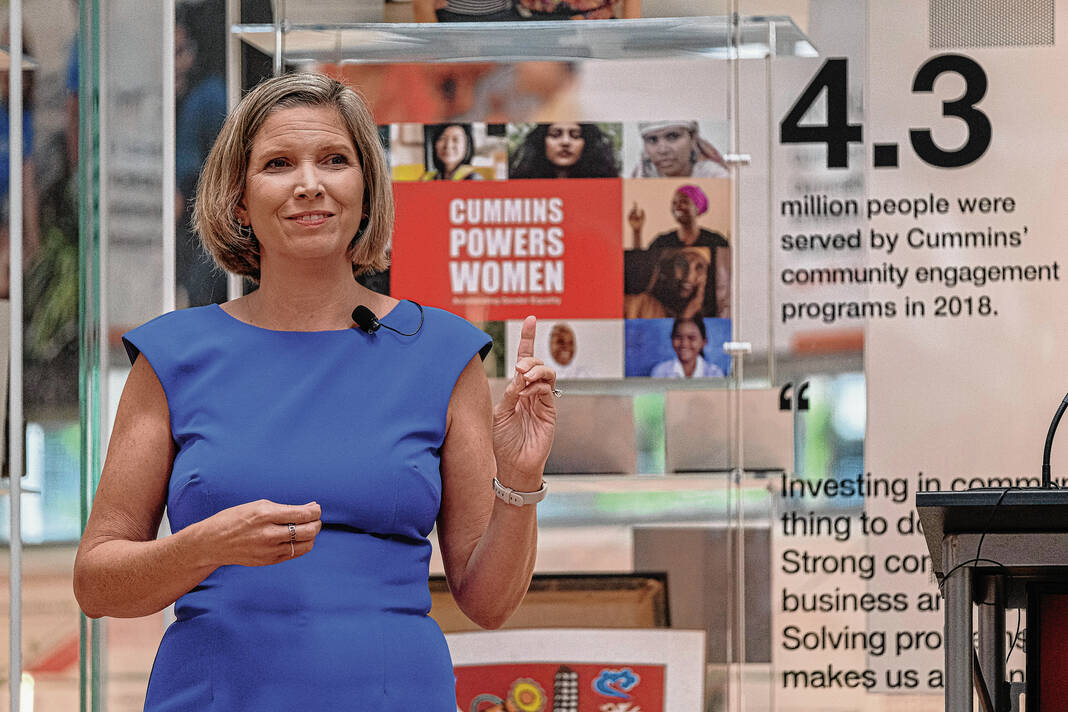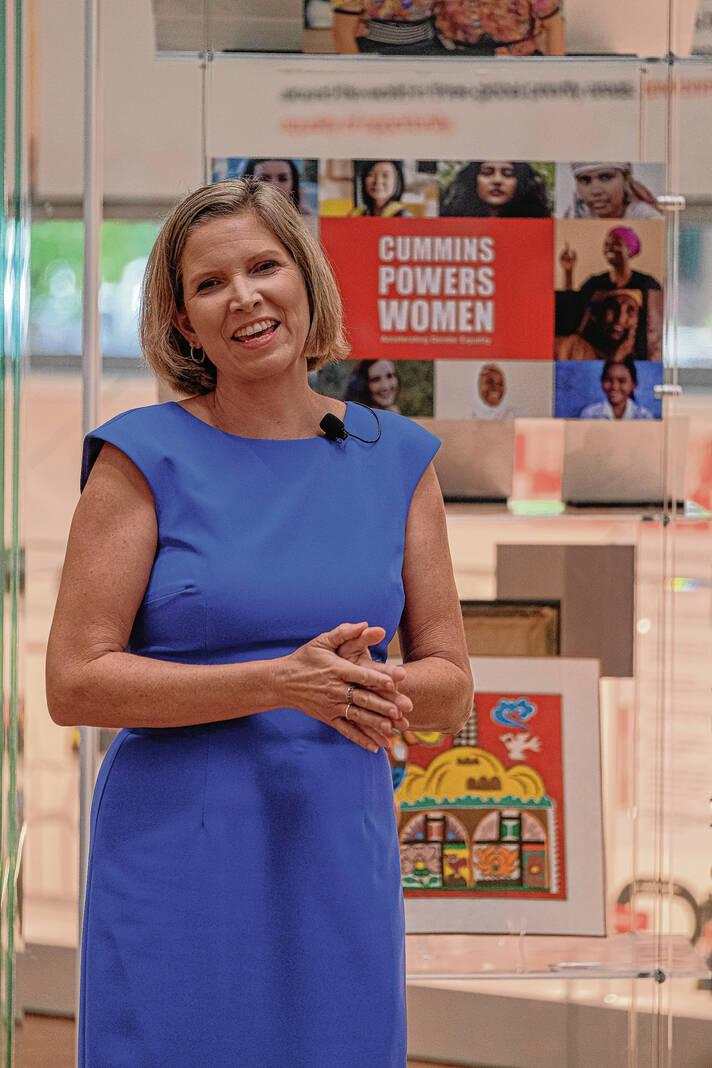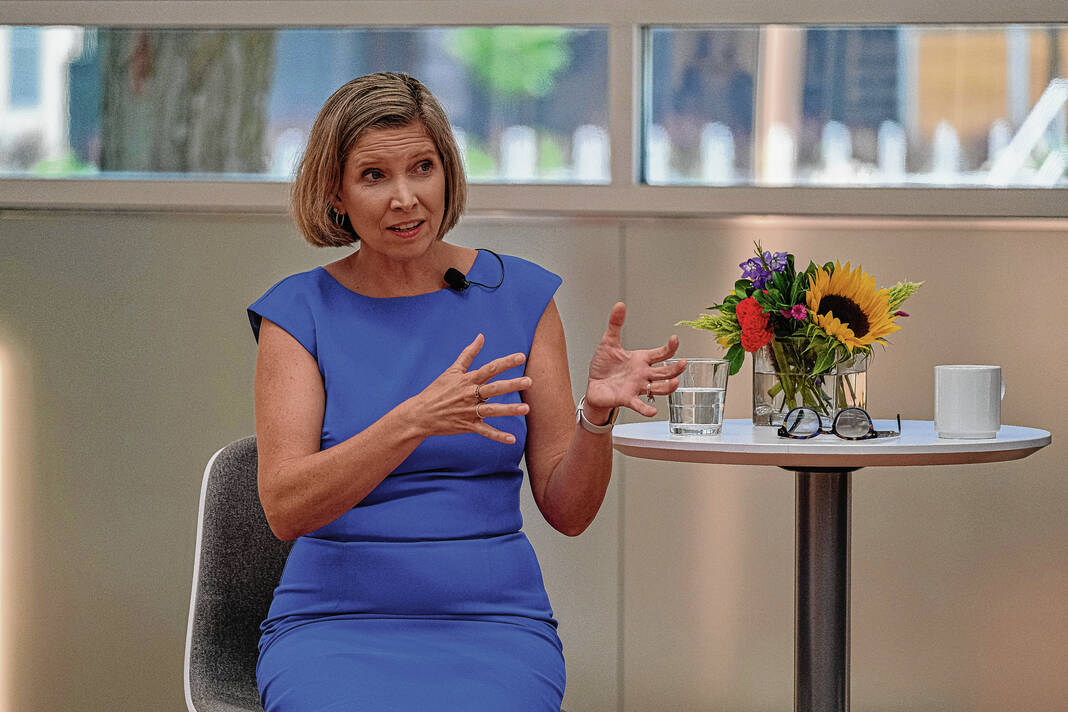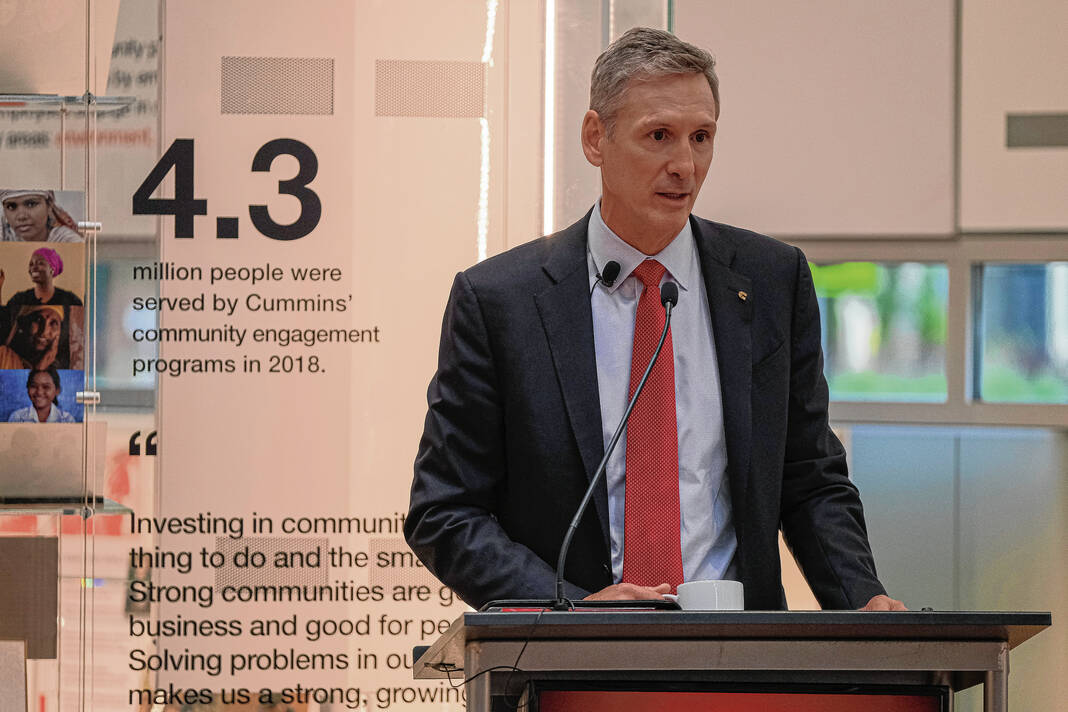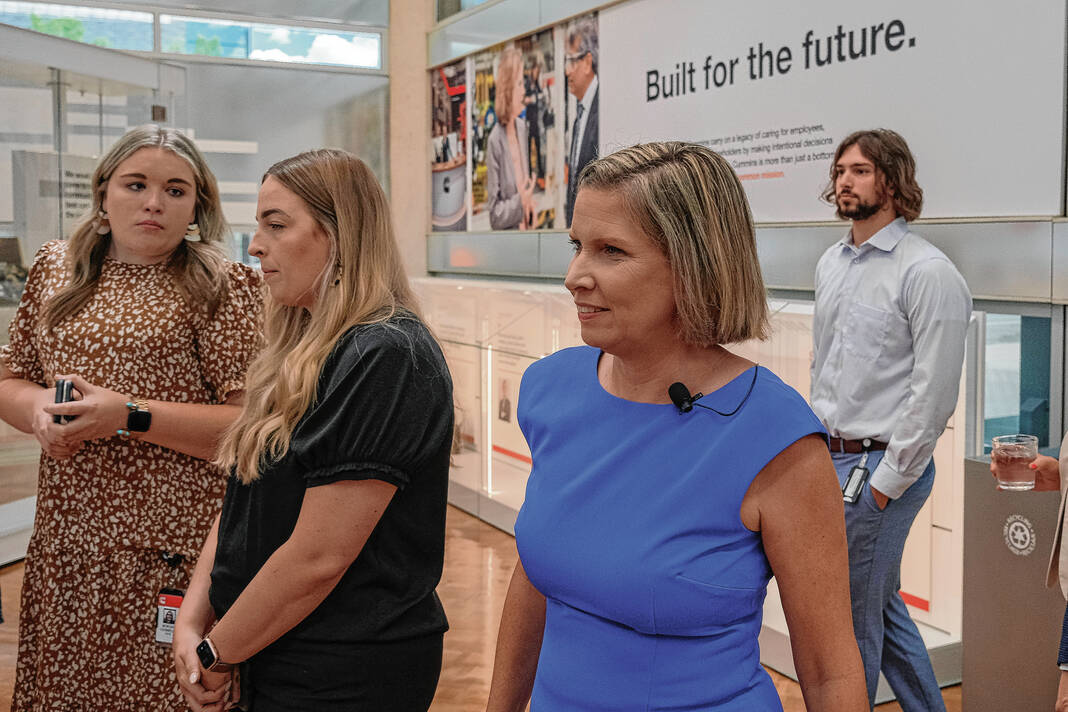Cummins Inc. has appointed Jennifer Rumsey as its new chief executive officer, selecting the Columbus native to steer the company through the industry’s transition to greener forms of energy.
Rumsey, 48, becomes the first woman and seventh person to hold the top spot in the company’s 103-year history, Cummins said. She has been with the Cummins for 22 years and was most recently promoted to president and chief operating officer last year, overseeing the company’s global operations.
Rumsey will take the reins of the Columbus-based company from current Chairman and CEO Tom Linebarger on Aug. 1.
Linebarger, 59, will continue to serve as chairman of the board and executive chairman, working with Rumsey on “specific initiatives that position the company for continued success,” including the pending acquisition of Meritor Inc.
Cummins is the largest employer in Bartholomew County, employing about 8,000 people in the Columbus area. The company also employs nearly another 1,100 people at the Seymour Engine Plant, Technical Center and Komatsu in Seymour. The company has 59,900 employees worldwide.
Rumsey will bring the total number of women leading S&P 500 companies to 34, Bloomberg News reported.
“I promise you, when I grew up in Columbus, Indiana, I would have never imagined that I would be standing here today as the next CEO for Cummins,” Rumsey said during a news conference Thursday at the company’s corporate headquarters in downtown Columbus. “… I’m incredibly honored and proud to serve as your next CEO.”
Energy transition
In running Cummins, the world’s largest maker of diesel engines, Rumsey assumes the challenge of leading the company as it seeks to secure its place in a world shifting away from fossil fuels.
Currently, the diesel industry finds itself at a crossroads of sorts, as alternative fuel technology grows in viability and concerns about climate change continue to reshape how companies and policy makers think about energy consumption.
At the same time, the coronavirus pandemic, supply chain challenges and inflation continue to disrupt global markets.
In February, Cummins outlined its long-term growth strategy, which officials said largely involves investing in and producing technology that company officials believe will play a key role in the path to zero emissions, including a broad range of clean diesel and other lower-emission technologies.
Company executives described the energy transition as a “growth opportunity” for Columbus’ largest employer and unveiled earlier this year an annual revenue target for the New Power segment of $6 billion to $13 billion by the end of the decade. By comparison, that segment pulled in $114 million in revenue last year.
Cummins’ New Power business segment includes the company’s growing electrified power and hydrogen portfolios and represents much of its efforts to invest in technologies that seek to curb greenhouse gas emissions.
The company’s New Power business is headquartered in Columbus.
“The company is going through a period of transformation,” Rumsey said in February. “…We also need to think about how we reposition the company for the future as decarbonization occurs.”
‘Followed my passion’
Rumsey, a 1992 graduate of Columbus East High School who still lives in Columbus, said in February that she “followed my passion” of working on “technologies that would make a difference” to Cummins.
She received a bachelor’s degree in mechanical engineering from Purdue University in 1996 and a master’s degree in mechanical engineering from the Massachusetts Institute of Technology in 1998.
Before joining Cummins, Rumsey started her career at a fuel cell startup company “because I wanted to work on interesting technology that would make a positive difference in the world.”
However, she left the startup company and joined Cummins in 2000 “because fuel cells were a long way from being a viable technology, and I wanted to work on technologies and products that really mattered to customers and made a difference in the environment.”
At Cummins, Rumsey has held a variety of roles and is among just a few women who have risen to the highest levels of the company’s hierarchy and the first to hold the chief executive officer role.
She has served as the vice president of engineering for the engine business, president of the company’s component business and became the first woman to hold the roles of chief technical officer and president and chief operations officer.
“We’re living in challenging period of time for our planet, for society, and it’s a really important time for Cummins,” Rumsey said. “Climate change is a real issue, and increasingly, we’re living in a society that is divided and dealing with change. I believe that this challenge period of time is the opportunity for us at Cummins to step up and shine. I feel a tremendous responsibility and also excitement for what’s ahead for Cummins.”
Rumsey file
Name: Jennifer Rumsey
Time with company: 22 years
-President and chief operating officer, March 2021 to present
-Vice president and president of components business, 2019 to 2021
–Vice president and chief technical officer, 2015 to 2019
-Vice president of engineering, engine business, 2013 to 2015
-Other positions, 2000 to 2015
Education: Purdue University, bachelor’s degree in mechanical engineering, master’s degree in mechanical engineering; Massachusetts Institute of Technology, master’s degree in mechanical engineering
Affiliations: Society of Women Engineers, Society of Automotive Engineers, Purdue Engineering Advisory Committee, Women in Trucking Association
Family: Husband, Jim; children, Helen and Katherine
Hometown: Columbus
—
Linebarger file
Name: Tom Linebarger
Time with company: 29 years
-President and chief executive officer, 2012 to present
-President and chief operating officer, 2008 to 2011
-Executive vice president and president, power generation business, 2003 to 2008
-Vice president and chief financial officer, 2000 to 2003
-Vice president, supply chain management, 1998 to 2000
-Other positions, 1993 to 2000
Education: Claremont McKenna College, bachelor’s degree in management engineering; Stanford University, bachelor’s degree in mechanical engineering; Stanford School of Engineering, master’s degree in manufacturing systems; Stanford Graduate School of Business, MBA
Boards: Harley-Davidson, Energy Systems Network
Family: Wife, Michele; children, Alex and Emily
Hometown: Los Altos, California
—
Cummins snapshot
Headquarters: Columbus
Employees: 59,900
Employees in Indiana: Estimated 8,000
Most recent earnings report:
— Reported $6.4 billion in revenue in the January-March period, up 5% compared to the first quarter last year. Sales were up 12% in North America, though international revenues declined 3% largely due to a sharp slowdown in China.
— First-quarter revenue topped Wall Street expectations of $6.03 billion, though earnings per share missed expectations of $3.55. However, earnings per share would have been $3.95 if not for the one-time costs of suspending operations in Russia, the company said. Overall, the company is projecting its revenues will be up 8% this year, largely fueled by stronger demand in North America and growth in most major regions except China. Cummins’ previous revenue forecast was 6%.
— The Cummins board of directors on Tuesday approved an increase in the company’s quarterly cash dividend on common stock of approximately 8% to 1.57 dollars per share from 1.45 dollars per share. The dividend is payable on Sept. 1 to shareholders of record on Aug. 19.
—
Cummins leadership
The chain of succession in the management of Cummins Inc. from 1919 to present:
The first leaders of Cummins Inc., then Cummins Engine Co., were an inventor-handyman and a banker. The inventor, Clessie Cummins, was the company’s first president when it was incorporated in 1919. Banker W.G. Irwin did not serve in any other company capacity beyond board member but was the principal financial backer and had the final say on major decisions.
W.G. Irwin’s nephew, J. Irwin Miller, joined the company in the capacity of general manager in 1934. Although Clessie Cummins continued as president, Miller’s responsibilities expanded over time. In 1946, he was elected president of the company shortly after Clessie left the position to become chairman of the board.
In 1951, Miller, recognizing that many of his duties needed to be passed on to others, appointed Robert E. Huthsteiner as president upon Clessie Cummins’ retirement. That same year, Miller was named chairman of the company.
Don Tull, who started his career at Cummins as a line worker, was named president in 1960 upon Huthsteiner’s resignation. Miller continued as chairman.
In 1969, Tull stepped down from the presidency, and Miller tapped Henry Schacht, a young Cummins executive who earlier had been recruited from Harvard University, as his replacement.
Some would say the modern-day Cummins succession strategy was launched in 1977 upon Miller’s retirement from the chairman’s office. Schacht was elected chairman and chief executive officer to replace him, and taking his place as president was Jim Henderson, a man Schacht would always refer to as “my partner.”
The Schacht-Henderson team would guide Cummins through the next 17 years. In 1994, Schacht stepped down as chief executive officer, and Henderson was elevated to the job. Six months later, Schacht turned over the chairman’s position to Henderson, and Tim Solso, who had joined the company in 1971, was elected to take Henderson’s old job as president. The Henderson-Solso team managed Cummins until late 1999 when Henderson announced his plans to retire. Solso was elected chairman and CEO.
In 2005, Joe Loughrey, who had been president of the Engine Business of the company, its largest sales division, was named president and chief operating officer.
Loughrey retired in 2008. His position as president and chief operating officer was taken by Tom Linebarger.
In 2011, Solso confirmed he planned to retire, and Linebarger was named chairman and CEO in 2012.
Cummins announced Thursday that effective Aug. 1, Linebarger will end his term as chief executive officer, and Jennifer Rumsey, president and chief operating officer, will assume the role of president and CEO.
Rumsey will be the seventh CEO and first woman to lead the company since it was founded in 1919.
Linebarger will continue to serve as chairman of the board of directors and in an executive chairman role.

